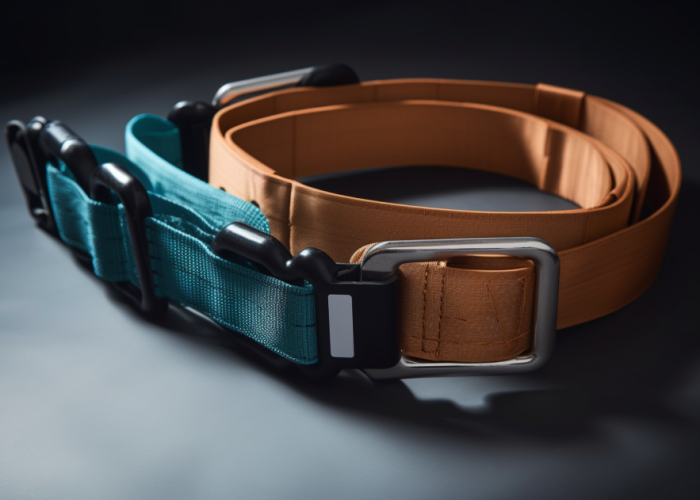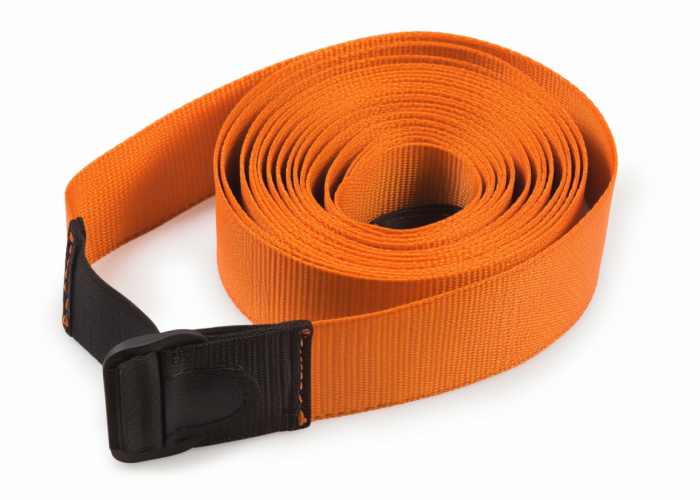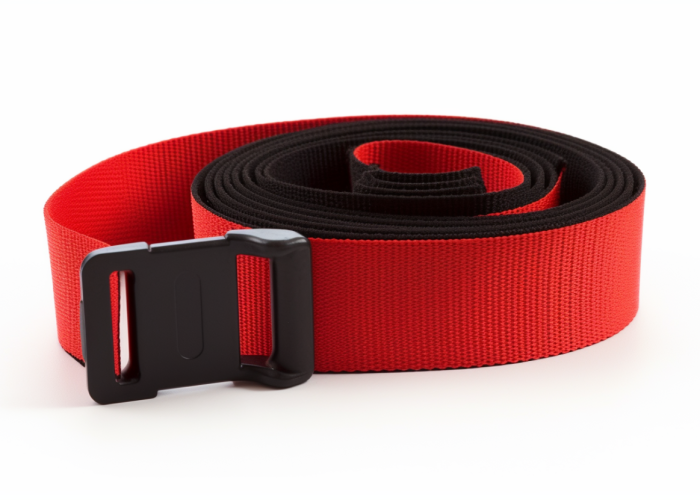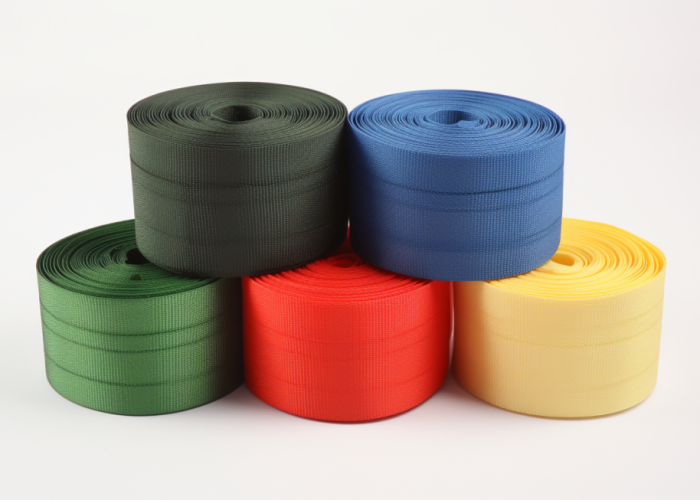Selecting the right webbing material for marine applications directly impacts product performance, durability, and user safety. Marine environments present unique challenges including UV exposure, saltwater immersion, and variable load conditions that demand specialized materials. As a custom webbing manufacturer, we provide engineered solutions tailored to specific marine applications, helping product developers optimize performance while managing costs.
Polyester is the best marine-grade webbing material, offering superior UV resistance, 95% strength retention when wet, and excellent durability at $0.25-$0.75 per foot. This versatile synthetic fiber maintains structural integrity for 3-5 years of outdoor exposure while providing sufficient tensile strength (2,000-3,000 lbs/in) for most marine applications.
Compare polyester, Kevlar, nylon, and polypropylene for marine webbing. Explore performance, durability, and environmental factors to choose the best material for your product.


Webbing manufacturing expert with 15+ years of experience helping product developers build high-performance straps for industrial, medical, and outdoor use.
Polyester outperforms other marine webbing materials with its superior combination of UV resistance, strength retention, and affordability at $0.25-$0.75 per foot. For marine equipment manufacturers and product developers, this balance of performance and cost makes polyester the standard choice for 75% of marine webbing applications including boat covers, sail handling systems, and general marine rigging.
At a glance:
Polyester’s molecular structure creates inherent resistance to UV radiation, the primary cause of webbing failure in marine environments. Unlike nylon that degrades after 6-12 months of sun exposure, polyester webbing maintains structural integrity for 3-5 years in identical conditions without special treatments or coatings.
For product developers, polyester’s consistent wet performance solves critical marine design challenges. With water absorption rated “very low” in comparison tests, polyester webbing maintains dimensional stability and 95% of its dry strength even after prolonged water exposure, eliminating the need for compensatory overengineering required with materials like nylon.
While Kevlar offers superior strength and aramid advantages for specialized applications, polyester provides sufficient strength (2,000-3,000 lbs/in) for most marine requirements at approximately one-fifth the cost. This practical balance makes polyester the optimal material for standard marine webbing applications, where extreme performance is unnecessary and cost-effectiveness is essential.
Available in various weights from lightweight 3/4″ (1,000 lb test) to heavy-duty 2″ (4,000+ lb test) configurations, polyester webbing can be customized to specific marine application requirements without the cost premium associated with high-performance alternatives.
Beyond polyester, specialized marine applications utilize nylon, polypropylene, Kevlar, and high-performance fibers for their unique performance characteristics. Each material offers specific advantages that make it the optimal choice for particular marine applications where standard polyester may not provide ideal performance.
At a glance:
Nylon webbing provides exceptional elongation and elasticity that polyester cannot match. This natural stretch (15-30%) makes nylon ideal for marine applications requiring shock absorption or energy dissipation, such as anchor lines, fender attachments, and safety tethers.
Polypropylene offers unique properties as the only webbing material that naturally floats on water. This characteristic, combined with its lightweight nature and good water resistance, makes it well-suited for water rescue equipment, float lines, and buoyancy applications.
For critical marine applications requiring maximum strength and durability, Kevlar and other high-performance fibers deliver exceptional performance characteristics necessary for safety-critical systems, offshore equipment, and high-stress marine components.

Kevlar delivers significantly higher strength, superior heat resistance, and exceptional durability compared to polyester, but at 5-10x higher cost ($3.00-$6.00/ft versus $0.25-$0.75/ft). This performance difference makes Kevlar the optimal choice for specialized marine applications where failure is not an option.
At a glance:
Kevlar’s aramid fiber construction creates molecular bonds that deliver exceptional tensile strength while maintaining low weight. This superior strength-to-weight ratio allows marine equipment designers to create stronger components without adding significant mass—critical for performance vessels and weight-sensitive applications.
Unlike polyester, Kevlar maintains its integrity in extreme temperature environments. With heat resistance up to 480°C compared to polyester’s 150°C limit, Kevlar webbing can withstand scenarios involving high friction, motor proximity, or exhaust exposure without compromising structural integrity.
Kevlar offers superior strength-to-weight ratio and extreme heat resistance at significantly higher cost, while polyester provides better UV protection, greater flexibility, and more economical pricing. These distinctions guide marine engineers in selecting the appropriate material for specific applications.
At a glance:
Kevlar’s molecular structure prioritizes tensile strength at the expense of flexibility. The comparison table shows Kevlar rated as “Low” for flexibility versus polyester’s “Moderate” rating. This rigidity makes Kevlar less suitable for applications requiring frequent bending or complex routing but ideal for straight-pull, high-stress applications.
UV resistance represents one area where polyester outperforms Kevlar. With an “Excellent” UV resistance rating versus Kevlar’s “Slightly high,” polyester maintains its structural integrity longer in applications with constant sun exposure.

Kevlar and high-performance fibers like Dyneema deliver the exceptional strength, durability, and safety factors necessary for critical marine applications where failure could result in injury or equipment damage. These premium materials provide performance that justifies their higher cost in high-stress marine environments.
At a glance:
Kevlar excels in marine applications requiring maximum tensile strength and heat resistance. Its exceptional performance makes it the preferred material for safety-critical components in harsh marine environments, including anchor bridles, towing hardware, and heavy equipment securing.
High-performance synthetic fibers like Dyneema and UHMWPE provide specialized performance characteristics that excel in specific critical applications. These materials offer unique combinations of properties including exceptional strength, reduced weight, and specialized performance characteristics that make them suitable for marine applications where standard materials would fail.
Environmental factors impact marine webbing materials differently, with polyester offering the best overall environmental resistance while specialized materials provide targeted protection against specific challenges. Understanding these environmental responses helps engineers select materials suited to specific marine exposure conditions.
At a glance:
UV radiation represents the most significant environmental threat to marine webbing materials. Polyester’s excellent UV resistance makes it the preferred material for continuous outdoor exposure, while polypropylene requires UV stabilizers or frequent replacement due to its poor natural resistance.
Saltwater immersion affects marine webbing primarily through potential absorption and chemical interaction. The comparison table shows polyester and Kevlar with “very low” water absorption ratings, maintaining dimensional stability and strength when wet. In contrast, nylon absorbs water, resulting in temporary strength reduction of approximately 15-20% when saturated.

Each marine webbing material serves specific applications where its unique properties provide optimal performance – nylon for shock absorption, polypropylene for flotation, and Kevlar for critical safety systems. Matching these specialized materials to their ideal use cases ensures maximum performance, durability, and safety in marine environments.
At a glance:
Nylon excels in applications requiring energy absorption thanks to its superior elasticity. This makes it essential for anchor lines, mooring systems, and safety tethers where sudden load spikes must be dampened. Available in standard widths from 1/2″ to 2″ with optional water-repellent treatments and 2-3 week lead times for specialized orders.
Polypropylene’s unique floating capability makes it irreplaceable for water rescue equipment, marker lines, and flotation systems. Available in high-visibility colors with UV stabilizers, with minimum orders of 500 feet for custom colors.
High-performance fibers like Dyneema deliver exceptional strength for extreme marine environments where conventional webbing would fail. Custom configurations available with 3-4 week lead times and minimum quantities of 250 feet.
Marine webbing prices range from economical polypropylene ($0.15-$0.25/ft) to premium Kevlar ($3.00-$6.00/ft), with polyester ($0.25-$0.75/ft) providing the best value for most applications. Understanding these cost differences helps engineers select materials that meet both performance requirements and budget constraints.
At a glance:
Polyester offers the best balance of performance and affordability for most marine applications. At $0.25-$0.75 per foot, it delivers excellent UV resistance, strength, and durability at a reasonable price point. Stocked in 12 standard colors with quick-ship availability.
Nylon’s moderate price ($0.50-$0.80/ft) provides specialized performance characteristics including superior elasticity and abrasion resistance for applications requiring energy absorption or resistance to wear.
Kevlar represents a premium investment at $3.00-$6.00 per foot, justified by its exceptional strength and durability in critical applications where failure would be catastrophic or where frequent replacement of standard materials would ultimately cost more.
Polyester delivers the best overall performance for most marine webbing applications, with specialized materials like Kevlar, nylon, and polypropylene offering advantages for specific requirements. When selecting marine webbing, balance performance needs with budget constraints and environmental exposure conditions. Contact us to explore manufacturing solutions tailored to your product requirements.
Marine-grade webbing offers superior environmental resistance, reliable load-bearing capacity, and extended service life in harsh conditions. These specialized materials resist UV degradation, saltwater corrosion, and chemical exposure while maintaining consistent performance across variable temperature ranges, unlike standard webbing that quickly deteriorates in marine environments.
Regular freshwater rinsing, periodic inspection for abrasion, and protection from prolonged sun exposure when not in use significantly extend marine webbing lifespan. For polyester webbing, mild soap cleaning is safe, while specialized materials like Kevlar should only be cleaned according to manufacturer guidelines to prevent damage to molecular structures that provide their unique performance properties.
Marine webbing must comply with ISO 9554 for fiber rope specifications, ASTM D6775 for webbing physical properties, and application-specific standards like UL 1500 for marine safety components. For international markets, additional certification may be required from maritime authorities including USCG, SOLAS, and CE marking for European markets, particularly for webbing used in safety-critical applications.
Kevlar’s exceptional strength-to-weight ratio (5x stronger than steel at 40% less weight) makes it ideal for performance-critical marine applications where minimizing mass is essential. This lightweight characteristic reduces overall equipment weight, improves fuel efficiency in powered vessels, and enhances performance in racing applications while maintaining superior strength compared to other webbing materials.
Custom marine webbing is manufactured through specialized weaving processes with specific fiber selection, weave pattern optimization, and application-specific treatments. Manufacturing capabilities include widths from 1/2″ to 4″, custom colors for brand alignment, specialized coatings for enhanced performance, and hybrid constructions that combine multiple materials for optimized performance in specific marine environments.
Implement appropriate safety factors (5:1 for critical applications), account for strength reduction in wet conditions, and consider UV degradation over time when selecting marine webbing. Materials should meet relevant marine safety standards including ISO 9554, ASTM D6775, and application-specific certifications, with critical safety applications requiring documented testing and regular inspection protocols.